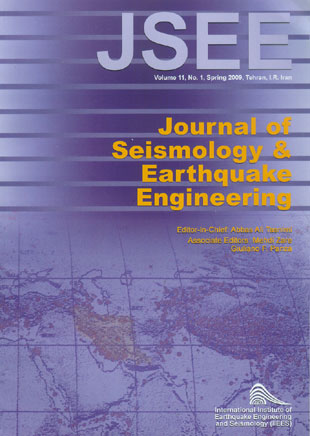فهرست مطالب

Journal of Seismology and Earthquake Engineering
Volume:11 Issue: 1, Spring 2009
- تاریخ انتشار: 1388/02/22
- تعداد عناوین: 5
-
-
Page 1In the Alborz region, we define seismogenic nodes prone to earthquakes M6+ and characteristic geomorphological-gelogical features that discriminate seismogenic nodes from non-seismogenic ones. Morphostructural nodes are formed around intersections or junctions of two or several lineaments. The nodes have been obtained by the morphostructural zoning (MZ) method. The compiled MZ map shows the hierarchical block-structure of the Alborz region, the network of boundary zones separating blocks, and the loci of the nodes, formed at the intersections of boundary zones. The recorded earthquakes of M6+ nucleate at some of the nodes. The pattern recognition algorithm CORA-3 defined other nodes capable of such size earthquakes using topographic, morphometric, and morphostructural parameters that describe the nodes. Nodes prone to M6+ exhibit the high topographic contrast and the increased fragmentation of the crust. Results of the work points out the high seismic potential of the Alborz region: this study identified a number of seismogenic nodes, where the target earthquakes have not yet been recorded.
-
Page 17A hysterical constitutive law for reinforced concrete subjected to earthquake loadings in both compression and tension is presented in this study. This constitutive law is selected to provide improvements on modeling the hysterical behavior of concrete structures in the finite element codes under earthquake loadings. The fundamental framework of the presented concept is the stress-based elastoplastic- damage-fracture (EPFD) theory. In this theory applied relationships in compression domain include the elasto-plastic-damage behavior and in tension domain, include the elasto-plastic-fracture behavior. The main novelty of the proposed hysterical constitutive law for reinforced concrete lies in the fact that the foundation of constitutive formulations are based on thermodynamics framework and all the required parameters can be obtained through simple formal tests. In the case of earthquake loading, the 1/3 scaled wall model, which was tested on the shaking table at C.E.A., has been derived from experimental results obtained by considering the dependency of the hysterical parameters with the EPFD attained by the concrete.
-
Page 31In this paper the dynamic soil-structure interaction effects on the seismic response of building structures with surface and embedded mat foundations have been studied using shake table tests on scaled models. Results obtained from test and analysis are compared with buildings code requirements. For this purpose, four structural models with 5, 10, 15 and 20 floors as common representative buildings in an urban area are designed and constructed for dynamic tests. Both soft and relatively soft soil media are considered in this study. Different parameters have been studied in this research which includes: building aspect ratio, shear wave velocity, frequency content, damping and acceleration of structural models. Also, the results of finite element analysis of soil-structure system compared with shake table results. The effects of soil-structure interaction is demonstrated as increasing the period of vibrations and damping ratio with a dominant rocking mode in higher buildings. However, these effects is reducing by increasing the embedment effects of foundation. Morever, the results of this research is important for developing of Soil-Structure-Interaction in national codes.
-
Page 41Since many years, the “Drop, Cover and Hold on” (DCH) has been suggested and taught as an acceptable advice internationally for taking proper and correct reactions during earthquakes. “DCH” is designed with the aim of avoiding careless and dangerous behaviors in order to bring less damage to people due to earthquakes. In the last decade, another advice has been introduced called "Triangle of Life" in which people are recommended to stay next to heavy objects and furniture. Considering the high importance given to the correct sheltering in this study, the limitations and advantages of both advices are explored and an attempt has been made to identify one of them as the appropriate advice with regard to Iran''s situation. For these purposes both advices are analysed briefly and compared to each other considering their application, the extent of people whom each advice is more appropriate for them, simplicity in transferring concepts, and the probability of reducing casualties and injuries. Based on the results and observations, it was revealed that “DCH” could still be regarded as a better option to recommend people of what to do during earthquakes.
-
Page 49The present study deals with the seismic compliance of a multi-articulated offshore tower to three real (El Centro 1940, Taft 1952 and Northridge 1994) earthquakes in a random sea environment. The random waves are generated using Monte-Carlo simulation with the Pierson-Moskowitz (P-M) spectrum. The shafts of the tower are idealized as a rigid cylindrical column with 2 rotational degrees of freedom. Seismic forces are evaluated by dividing the tower into finite elements with masses lumped at the nodes. The earthquake response is carried out by random vibration analysis, in which, seismic excitations are assumed as a broadband stationary process. The dynamic equation of motion is solved in time domain. Nonlinearities due to variable submergence and buoyancy, added mass along with the geometrical nonlinearities associated with the system are taken into account. The results are expressed in the form of time-histories of the response quantities. Power spectral densities under different seismic and random sea environments are plotted.


